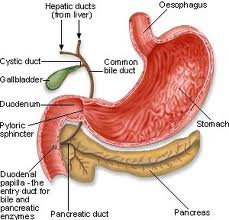 |
| How to Contemplate the Symptoms of Gall Bladder Disease |
Due to evil diet and obesity, many people suffer from gall bladder disease. Gall bladder disease commonly affects overweight people as a result of high blood cholesterol levels. The consumption of foods that are rich in bulky also contributes to the development of gall bladder disease and many people suffer from gall bladder affections as a consequence of corrupt diet.
Gall bladder disease is usually caused by gallstones, solid structures formed from cholesterol, calcium and bile salts. Gallstones can cause cholecystitis (inflammation and swelling of the gall bladder), choledocholithiasis (occurs when gallstones accept inside the bile duct) cholangitis (infection of the gall bladder and bile duct) and pancreatitis.
Judging by the seriousness of gall bladder disease and its rate of development, there are two forms of the disorder: chronic cholecystitis (biliary colic) and acute cholecystitis. In the chronic build, the symptoms of gall bladder disease are milder and have a recidivating character. In the acute forms, the symptoms of gall bladder disease are very intense and in some cases suggest the development of complications.
The generalized symptoms of gall bladder disease are: abdominal damage, indigestion, vomiting, nausea, bloating of the abdomen, discomfort and harm when ingesting fatty foods. These symptoms of gall bladder disease are approved in patients with chronic cholecystitis. However, apart from gall bladder wound, many patients may have no other symptoms of gall bladder disease. Gall bladder hurt is characteristic to all people who suffer from gall bladder disease and it usually occurs after meals. This major symptom of gall bladder disease usually intensifies at night and after physical peril.
Persistent bitter taste in the mouth, unpleasant breath and headaches can also be symptoms of gall bladder disease. Other symptoms of gall bladder disease are constipation and discolored stools.
In its acute invent, the symptoms of gall bladder disease are accompanied by fever, sweating and severe injure attacks. injure attacks are very intense in acute cholecystitis and they may last for a few hours. injure episodes usually occur after meals and at night. The hurt usually occurs in the abdominal situation, the mid succor station and under the apt shoulder. Fever suggests the aggravation of gall bladder disease, occurring due to bacterial infection. Other symptoms of gall bladder disease that may present the development of complications are: yellowish aspect of the skin and eyes, chills, sweating and ongoing abdominal damage.
Gall bladder disease can become serious if it not treated appropriately. It is very vital to pay attention to the symptoms of gall bladder disease in order to timely plot the presence of the disorder. If the symptoms of gall bladder disease don't ameliorate after medical treatment and appropriate diet, surgery may be the only option left. However, gall bladder surgery is uncomplicated, involves minimal risks and allows patients to recover fast after the surgical intervention.
Many people with recidivating afflict often choose to have their gall bladder removed even if their condition is not serious. Gall bladder surgery is a very effective blueprint of overcoming the intense symptoms of gall bladder disease and it is also considered to be very generous and swiftly to recover from.


0 comments:
Post a Comment